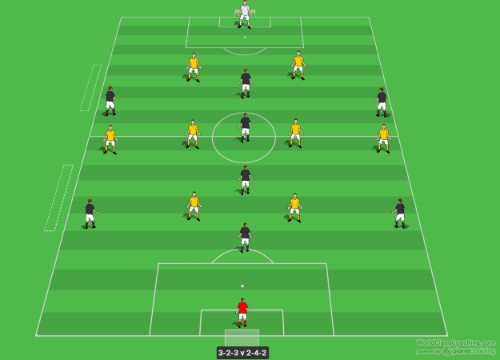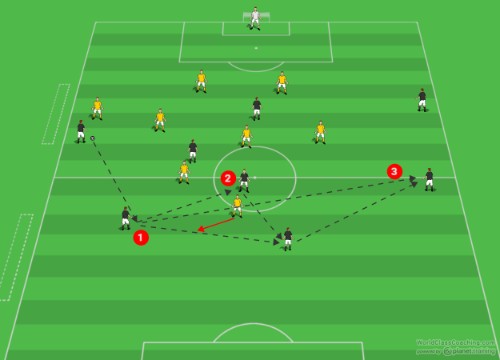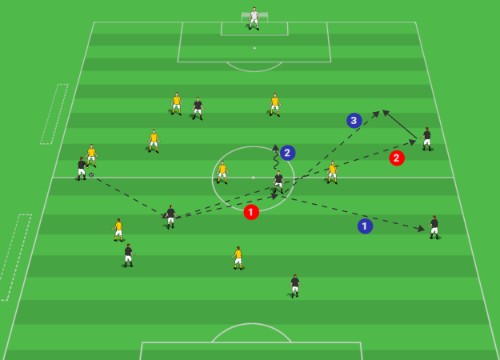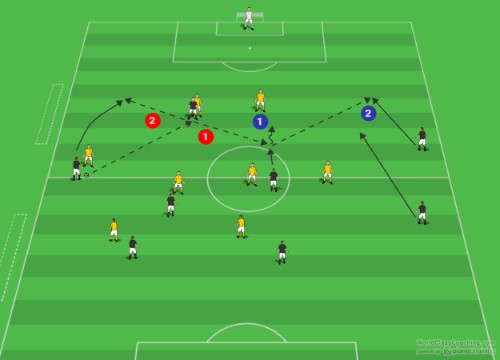By Sean Pearson
With the new USSF mandated birth year and small sided games changes there is a lot of trial and error regarding formations and systems of play. Instead of 8v8 formations, as coaches, we are now trying to figure out how to position our players in the new 7 v 7 and 9 v 9 formations. Some clubs have an academy structure where all teams must play the same formation, others allow coaches to choose what works for their team because players in each team have different attributes.
In these Systems of Play articles, I aim to address a wide range of 7 v 7, 9 v 9 and 11 v 11 formations and ways in which to use your players to your advantage.
Formation
I will look at when, where and how players should change the point of attack in the 3-2-3 against a 2-4-2. The same options can be used in other formations but players must support the player on the ball at the right angles and in the right positions.

Changing the Point of Attack
The first decision is always when you should change the point of attack. There can be many scenarios when it is needed but I will concentrate on the most common. When your winger/wide striker has the ball and the opposition slide over to compact the space in and around that side of the field. Players drop deeper which leaves space behind the winger and on the opposite side.
Your players must recognize this scenario and see that space is limited on one side but open on the other. They must communicate and get into positions to facilitate a change in the point of attack. The left full back in the scenario below creates an angle from the winger, the center back and opposite full back stretch the field to give them more space.
- The team can do the standard ‘U’ change of attack by using the defense. This has the highest percentage of success but is also the slowest and allows the opposition time to slide all the way across to stop progress on the opposite side. So in any switch the passes and decisions must be fast paced.
- If a striker from the opposite team blocks the pass from full back to center back, a center midfielder can be used as an option to ‘bounce’ the ball to the center back (they could also play the ball straight across the full back).
- This is the hardest technically to accomplish but should still be encouraged if the player is able to perform the task. The ball is played, over the opposition striker, directly to the full back.

Another way of changing the point of attack is to use the two midfield players. This is higher risk but can eliminate the 2 strikers who are looking to stop the switch via the defenders. Again, the winger needs an angle of support, this time from the closest center midfielder. It is also important that your other center midfielder is in the middle of the first center midfielder and the winger this helps with distance of pass. They should also be ahead of them to give an angle forwards (You can do another ‘U’ switch in the midfield but this is slower and predictable).
- The 1st center midfielder passes across to the 2nd center midfielder. Here the 2nd midfielder has a choice.
- They can play to the full back who has the space to advance forwards. (This is usually the option if there is pressure from behind)
- They can get information from checking their shoulder or teammate communication to turn and drive with the ball.
3) They can play a ball out wide, in front of the winger to lead them to attack that side (they can also play this pass after driving at the center back, committing them, and then sliding the winger in as this is a 2v1).

The last way of changing the point of attack is through the striker. This option is used when the opposition does not cut off the option to the striker like in previous scenarios.
- The striker will most likely have pressure directly behind them, if they do not then another option would be to turn and attack the goal themselves. But in this scenario they play across to an attacking central midfielder.
- This midfielder can then drive at the center back and take them on
- Pass across to the winger/striker on the opposite side so they can attack the goal (the midfielder can also draw the center back out and then slide in the wide player and so utilizing the 2v1.)
- Although not changing the side of the attack, you are changing the angle and point by completing a give and go around the opposition player. Now the point is further up that side of the field with more space.

The biggest obstacle is the understanding your players have of knowing when to change the point, why, how and where to then attack from. A lot of young players think to be good at the sport they must be the one that beats a player or does something and so they try to force the ball down the side with no space. Encourage them to understand that even the best players do the simple things when it is necessary, they choose their moments in better scenarios for them. Develop your players’ understanding that making better decisions makes them a better player not trying to force the ball into an area it should not be taken.
By Sean Pearson. Sean is also the author Coaching Team Shape in the 3-3-1, Coaching Team Shape in the 4-2-3-1 and Coaching Team Shape in the 4-3-3


